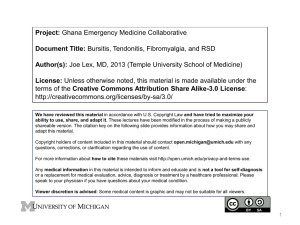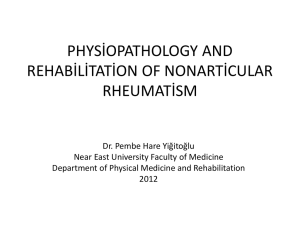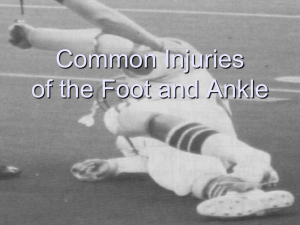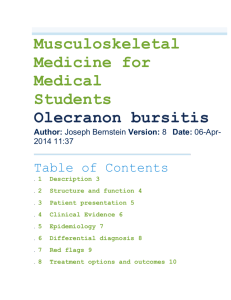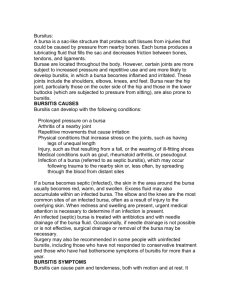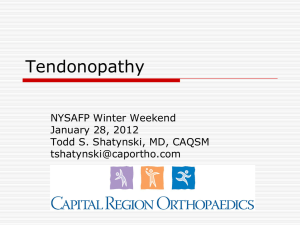PowerPoint – Bursitis & Tendonitis
advertisement
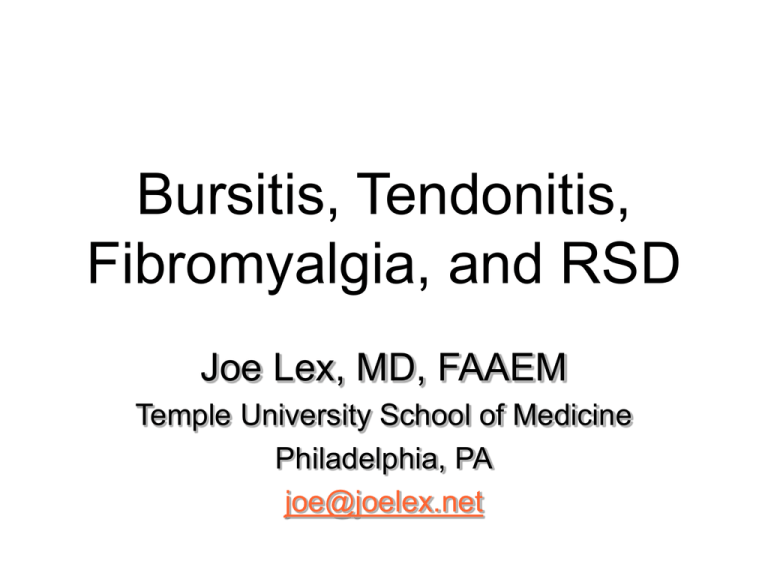
Bursitis, Tendonitis, Fibromyalgia, and RSD Joe Lex, MD, FAAEM Temple University School of Medicine Philadelphia, PA joe@joelex.net Objectives 1. Explain how bursitis and tendonitis are similar 2. Explain how bursitis and tendonitis differ from from another 3. List phases in development and healing of bursitis and tendonitis Objectives 4. List common types of bursitis and tendonitis found at the: Shoulder Elbow Wrist Hip Knee Ankle 5. List indications / contraindications for injection therapy of bursitis and tendonitis Objectives 6. Describe typical findings in a patient with fibromyalgia 7. Describe typical findings in a patient with reflex sympathetic dystrophy Sports • • • • Society more athletic Physical activity health benefits Overuse syndromes increase 25% to 50% of participants will experience tendonitis or bursitis Workplace Musculoskeletal disorders from… …repetitive motions …localized contact stress …awkward positions …vibrations …forceful exertions • Ergonomic design incidence Bursae • Closed, round, flat sacs • Lined by synovium • May or may not communicate with synovial cavity • Occur at areas of friction between skin and underlying ligaments / bone Bursae • Permit lubricated movement over areas of potential impingement • Many are nameless • ~78 on each side of body • New bursae may form anywhere from frequent irritation Bursitis Inflamed by… …chronic friction …trauma …crystal deposition …infection …systemic disease: rheumatoid arthritis, psoriatic arthritis, gout ankylosing spondylitis Bursitis • Inflammation causes bursal synovial cells to thicken • Excess fluid accumulates inside and around affected bursae Tendons • Tendon sheaths composed of same synovial cells as bursae • Inflamed in similar manner • Tendonitis: inflammation of tendon only • Tenosynovitis: inflammation of tendon plus its sheath Tendons • Inflammatory changes involving sheath well documented • Inflammatory lesions of tendon alone not well documented • Distinction uncertain: terms tendonitis and tenosynovitis used interchangeably Tendons • Most overuse syndromes are NOT inflammatory • Biopsy: no inflammatory cells • High glutamate concentrations • NSAIDs / steroids: no advantage • TendonITIS a misnomer Bursitis / Tendonitis • Most common causes: mechanical overload and repetitive microtrauma • Most injuries multifactorial Bursitis / Tendonitis • Intrinsic factors: malalignment, poor muscle flexibility, muscle weakness or imbalance • Extrinsic factors: design of equipment or workplace and excessive duration, frequency, or intensity of activity Immediate Phase • Release of chemotactic and vasoactive chemical mediators • Vasodilation and cellular edema • PMNs perpetuate process • Lasts 48 hours to 2 weeks • Repetitive insults prolong inflammatory stage Healing Phase • Classic inflammatory signs: pain, warmth, erythema, swelling • Healing goes through proliferative and maturation • 6 to 12 weeks: organization and collagen cross-linking mature to preinjury strength History • Changes in sports activity, work activities, or workplace • Cause not always found • Pregnancy, quinolone therapy, connective tissue disorders, systemic illness History • Most common complaint: PAIN • Acute or chronic • Frequently more severe after periods of rest • May resolve quickly after initial movement only to become throbbing pain after exercise Articular vs. Periarticular In joint capsule • Joint pain / warmth / swelling • Worse with active & passive movement • All parts of joint involved Periarticular • Pain not uniform across joint • Pain only certain movements • Pain character & radiation vary Physical Exam • Careful palpation • Range of motion • Heat, warmth, redness Lab Studies • Screening tests: CBC, CRP, ESR • Chronic rheumatic disease: mild anemia • Rheumatoid factor, antinuclear antibody, antistreptolysin O titers, and Lyme serologies for follow-up • Serum uric acid: not helpful Synovial Fluid • Especially crystalline, suppurative etiology • Appearance, cell count and diff, crystal analysis, Gram’s stain • Positive Gram’s: diagnostic • Negative Gram’s: cannot rule out Management • • • • Rest Pain relief: meds, heat, cold No advantage to NSAIDs Exceptions: olecranon bursitis and prepatellar bursitis have a moderate risk of being infected (Staphylococcus aureus) Management • Shoulder: immobilize few days • Risk of adhesive capsulitis • Lateral epicondylitis: forearm brace • Olecranon bursitis: compression dressing Management • De Quervain’s: splint wrist and thumb in 20o dorsiflexion • Achilles tendonitis: heel lift or splint in slight plantar flexion Local Injection Local Injection • Lidocaine or steroid injection can overcome refractory pain • Steroids universally given, often with great success • No good prospective data to support or refute therapeutic benefit Local Injection • Short course of oral steroid may produce statistically similar results • Primary goal of steroid injection: relieve pain so patient can participate in physical rehab Local Injection • Adjunct to other modalities: pain control, PT, exercise, OT, relative rest, immobilization • Additional pain control: NSAIDs, acupuncture, ultrasound, ice, heat, electrical nerve stimulation Local Injection • Analgesics + exercise: better results than exercise alone • Eliminate provoking factors • Avoid repeat steroid injection unless good prior response • Wait at least 6 weeks between injections in same site Indications Diagnosis • Obtain fluid for analysis • Eliminate referred pain Therapy • Give pain relief • Deliver therapeutic agents Contraindication: Absolute • • • • • • • Bacteremia Infectious arthritis Periarticular cellulitis Adjacent osteomyelitis Significant bleeding disorder Hypersensitivity to steroid Osteochondral fracture Contraindication: Relative • • • • • • • • Violation of skin integrity Chronic local infection Anticoagulant use Poorly controlled diabetes Internal joint derangement Hemarthrosis Preexisting tendon injury Partial tendon rupture Preparations • • • • Local anesthetic Hydrocortisone / corticosteroid Rapid anti-inflammatory effect Categorized by solubility and relative potency • High solubility short duration • Absorbed, dispersed more rapidly Preparations • Triamcinolone hexacetonide: least soluble, longest duration • Potential for subcutaneous atrophy • Intra-articular injections only • Methylprednisolone acetate (DepoMedrol®): reasonable first choice for most ED indications Dosage • Large bursa: subacromial, olecranon, trochanteric: 40 – 60 mg methylprednisolone • Medium or wrist, knee, heel ganglion: 10 – 20 mg • Tendon sheath: de Quervain, flexor tenosynovitis: 5 – 15 mg Site Preparation • Use careful aseptic technique • Mark landmarks with skin pencil, tincture of iodine, or thimerosal (Merthiolate®) (sterile Q-tip) • Clean point of entry: povidoneiodine (Betadine®) and alcohol • Do not need sterile drapes Technique • Make skin wheal: 1% lidocaine or 0.25% bupivacaine OR… …use topical vapocoolant: e.g., Fluori-Methane® • Use Z-tract technique: limits risk of soft tissue fistula • Agitate syringe prior to injection: steroid can precipitate or layer Complications: Acute • Reaction to anesthetic: rare • Treat as in standard textbooks • • • • Accidental IV injection Vagal reaction: have patient flat Nerve injury: pain, paresthesias Post injection flare: starts in hours, gone in days (~2%) Complications: Delayed • Localized subcutaneous or cutaneous atrophy at injection site • Small depression in skin with depigmentation, transparency, and occasional telangiectasia • Evident in 6 weeks to 3 months • Usually resolve within 6 months • Can be permanent Complications: Delayed • • • • Tendon rupture: low risk (<1%) Dose-related Related to direct tendon injection? Limit injections to no more than once every 3 to 4 months • Avoid major stress-bearing tendons: Achilles, patellar Complications: Delayed • Systemic absorption slower than with oral steroids • Can suppress hypopituitaryadrenal axis for 2 to 7 days • Can exacerbate hyperglycemia in diabetes • Abnormal uterine bleeding reported Some specific entities… Bicipital Tendonitis • Risk: repeatedly flex elbow against resistance: weightlifter, swimmer • Tendon goes through bicipital (intertubercular) groove • Pain with elbow at 90° flexion, arm internally / externally rotated Bicipital Tendonitis • Range of motion: normal or restricted • Strength: normal • Tenderness: bicipital groove • Pain: elevate shoulder, reach hip pocket, pull a back zipper Bicipital Tendonitis • Lipman test: "rolling" bicipital tendon produces localized tenderness • Yergason test: pain along bicipital groove when patient attempts supination of forearm against resistance, holding elbow flexed at 90° against side of body Calcific Tendonitis Supraspinatus Tendonitis Subacromial Bursitis • Calcific (calcareous) tendonitis: hydroxyapatite deposits in one or more rotator cuff tendons • Commonly supraspinatus • Sometimes rupture into adjacent subacromial bursa • Acute deltoid pain, tenderness Calcific Tendonitis Supraspinatus Tendonitis Subacromial Bursitis • Clinically similar: difficult to differentiate • Rotator cuff: teres minor, supraspinatus, infraspinatus, subscapularis • Insert as conjoined tendon into greater tuberosity of humerus Calcific Tendonitis Supraspinatus Tendonitis Subacromial Bursitis Jobe’s sign, AKA “empty can test” • Abduct arm to 90o in the scapular plane, then internally rotate arms to thumbs pointed downward • Place downward force on arms: weakness or pain if supraspinatus Calcific Tendonitis Supraspinatus Tendonitis Subacromial Bursitis • Other tests: Neer, Hawkins • Passively abduct arm to 90°, then passively lower arm to 0° and ask patient to actively abduct arm to 30° Calcific Tendonitis Supraspinatus Tendonitis Subacromial Bursitis • If can abduct to 30° but no further, suspect deltoid • If cannot get to 30°, but if placed at 30° can actively abduct arm further, suspect supraspinatus • If uses hip to propel arm from 0° to beyond 30°, suspect supraspinatus Calcific Tendonitis Supraspinatus Tendonitis Subacromial Bursitis • Subacromial bursa: superior and lateral to supraspinatus tendon • Tendon and bursa in space between acromion process and head of humerus • Prone to impingement • • • • • Calcific Tendonitis / Supraspinatus Tendonitis / Subacromial Bursitis Patient holds arm protectively against chest wall May be incapacitating All ROM disturbed, but internal rotation markedly limited Diffuse perihumeral tenderness X-ray: hazy shadow Rotator Cuff Tear • Drop arm test: arm passively abducted at 90o, patient asked to maintain dropped arm represents large rotator cuff tear • Shrug sign: attempt to abduct arm results in shrug only Elbow and Wrist Lateral Epicondylitis • Pain at insertion of extensor carpi radialis and extensor digitorum muscles • Radiohumeral bursitis: tender over radiohumeral groove • Tennis elbow: tender over lateral epicondyle Lateral Epicondylitis • History repetitive overhead motion: golfing, gardening, using tools • Worse when middle finger extended against resistance with wrist and the elbow in extension • Worse when wrist extended against resistance Medial Epicondylitis • “Golfer's elbow” or “pitcher’s elbow” similar • Much less common • Worse when wrist flexed against resistance • Tender medial epicondyle Cubital Tunnel Syndrome • Ulnar nerve passes through cubital tunnel just behind ulnar elbow • Numbness and pain small and ring fingers • Initial treatment: rest, splint Olecranon Bursitis • “Student's” or “barfly elbow” • Most frequent site of septic bursitis • Aseptic: motion at elbow joint complete and painless • Septic: all motion usually painful Olecranon Bursitis Aseptic olecranon bursitis • Cosmetically bothersome, usually resolves spontaneously • If bothersome, aspiration and steroid injection speed resolution • Oral NSAID after steroid injection does not affect outcome Septic Olecranon Bursitis • Most common septic bursitis: olecranon and prepatellar • 2o to acute trauma / skin breakage • Impossible to differentiate acute gouty olecranon bursitis from septic bursitis without laboratory analysis Ganglion Cysts • Swelling on dorsal wrist • ~60% of wrist and hand soft tissue tumors • Etiology obscure • Lined with mesothelium or synovium • Arise from tendon sheaths or near joint capsule Carpal Tunnel Syndrome • Median nerve compression in fibro-osseous tunnel of wrist • Pain at wrist that sometimes radiates upward into forearm • Associated with tingling and paresthesias of palmar side of index and middle fingers and radial half of the ring finger Carpal Tunnel Syndrome • Patient wakes during night with burning or aching pain, numbness, and tingling • Positive Tinel sign: reproduce tingling and paresthesias by tapping over median nerve at volar crease of wrist Carpal Tunnel Syndrome • Positive Phalen test: flexed wrists held against each other for several minutes in effort to provoke symptoms in median nerve distribution Carpal Tunnel Syndrome • May be idiopathic • Known causes: rheumatoid arthritis pregnancy, diabetes, hypothyroidism, acromegaly Carpal Tunnel Syndrome • Insert needle just radial or ulnar to palmaris longus and proximal to distal wrist crease • Ulnar preferred: avoids nerve • Direct needle at 60° to skin surface, point toward tip of middle finger de Quervain’s Disease • Chronic teno-synovitis due to narrowed tendon sheaths around abductor policis longus and extensor pollicis brevis muscles de Quervain’s Disease • 1st dorsal compartment • Radial border of anatomic snuffbox • 1st compartment may cross over 2nd compartment (ECRL/B) proximal to extensor retinaculum • Steroid injections relieve most symptoms Trigger Finger • Digital flexor tenosynovitis • Stenosed tendon sheath • Palmar surface over MC head • Intermittent tendon “catch” • “Locks” on awakening • Most frequent: ring and middle Trigger Finger • Tendon sheath walls lined with synovial cells • Tendon unable to glide within sheath • Initial treatment: splint, moist heat, NSAID • Steroid for recalcitrant cases Hip and Groin Trochanteric Bursitis • Second leading cause of lateral hip pain after osteoarthritis • Discrete tenderness to deep palpation • Principal bursa between gluteus maximus and posterolateral prominence of greater trochanter Trochanteric Bursitis • Pain usually chronic • Pathology in hip abductors • May radiate down thigh, lateral or posterior • Worse with lying on side, stepping from curb, descending steps Trochanteric Bursitis • Patrick fabere sign (flexion, abduction, external rotation, and extension) may be negative • Passive ROM relatively painless • Active abduction when lying on opposite side pain • Sharp external rotation pain Ischiogluteal Bursitis • Weaver's bottom / tailor’s seat: pain center of buttock radiating down back of leg • Often mistaken for back strain, herniated disk • Pain worse with sitting on hard surface, bending forward, standing on tiptoe Ischiogluteal Bursitis • Tenderness over ischial tuberosity • Ischiogluteal bursa adjacent to ischial tuberosity, overlies sciatic / posterior femoral cutaneous nerves Legs and Feet Prepatellar Bursitis • Housemaid’s knee / nun’s knee: swelling with effusion of superficial bursa over lower pole of patella • Passive motion fully preserved • Pain mild except during extreme knee flexion or direct pressure Prepatellar Bursitis • Pressure from repetitive kneeling on a firm surface: rug cutter's knee • Rarely direct trauma • Second most common site for septic bursitis Baker’s Cyst • Pseudothrombophlebitis syndrome • Herniated fluid-filled sacs of articular synovial membrane that extend into popliteal fossa • Causes: trauma, rheumatoid arthritis, gout, osteoarthritis • Pain worse with active knee flexion Baker’s Cyst • Can mimic deep venous thrombosis • Ultrasound eseential • Many resolve over weeks • May require surgery • Steroid injections not performed: risk of neurovascular injury Anserine Bursitis • Cavalryman's disease / pes bursitis / goosefoot bursitis: obese women with large thighs, athletes who run • Anteromedial knee, inferior to joint line at insertion of sartorius, semitendinous, and gracilis tendon Anserine Bursitis • Abrupt knee pain, local tenderness 4 to 5 cm below medial aspect of tibial plateau • Knee flexion exacerbates Iliotibial Band Syndrome • Lateral knee pain • Cyclists, dancers, distance runners, football players • Pain worse climbing stairs • Tenderness when patient supine, knee flexed to 90o Ankle and Foot Peroneal Tendonitis • Peroneal tendons cross behind lateral malleolus • Running, jumping, sprain • Holding foot up and out against downward pressure causes pain Peroneal Tendon Rupture • Torn retinaculum • Have patient dorsiflex and plantar flex with foot in inversion • Feel for “snapping” behind lateral malleolus Retrocalcaneal Bursitis • Ankle overuse: excessive walking, running, or jumping • Heel pain: especially with walking, running, palpation • Haglund disease: bony ridge on posterosuperior calcaneus • Treatment: open heels (clogs), bare feet, sandals, or heel lift Plantar Fasciitis • Policeman's heel / soldier's heel: associated with heel spurs • Degenerated plantar fascial band at origin on medial calcaneous • Heel pain worse in morning and after long periods of rest • May be relieved with activity Plantar Fasciitis • Microtears in fascia from overuse? • Eliminate precipitators, rest, strength and stretching exercises, arch supports, and night splints • Sometimes need steroid injection • Risk of plantar fascia rupture and fat pad atrophy Tarsal Tunnel Syndrome • Between medial malleolus and flexor retinaculum • Vague pain in sole of foot: burning or tingling • Worse with activity, especially standing, walking for long periods • Tender along course of nerve Tarsal Tunnel Syndrome • Between medial malleolus and flexor retinaculum • Vague pain in sole of foot: burning or tingling • Worse with activity, especially standing, walking for long periods • Tender along course of nerve Fibromyalgia Fibromyalgia • Pain in muscles, joints, ligaments and tendons • “Tender points“ • Knees, elbows, hips, neck • 5% of population, including kids • Main symptom: sensitivity to pain Fibromyalgia • Pain: chronic, deep or burning, migratory, intermittent • Fatigue, poor sleep • Numbness or tingling • “Poor blood flow” • Sensitivity to odors, bright lights, loud noises, medicines Fibromyalgia • • • • • • • Jaw pain Dry eyes Difficulty focusing Dizziness Balance problems Chest pain Rapid or irregular heartbeat Fibromyalgia • • • • • • • Shortness of breath Difficulty swallowing Heartburn Gas Cramping abdominal pain Alternating diarrhea & constipation Frequent urination Fibromyalgia • • • • • • • Pain in bladder area Urgency Pelvic pain Painful menstrual periods Painful sexual intercourse Depression Anxiety Compare to Somatization Somatization Fibromyalgia Vomiting Abdominal pain Nausea Bloating Diarrhea Leg / arm pain Back pain Compare to Somatization Somatization Fibromyalgia Joint pain Dysuria Headaches Breathlessness Palpitations Chest pain Dizziness Compare to Somatization Somatization Fibromyalgia Amnesia Dysphagia Vision changes Weak muscles Sexual apathy Dyspareunia Impotence Compare to Somatization Somatization Fibromyalgia Dysmenorrhea Irregular menstruation Excessive menstrual flow Fibromyalgia • Treatment Reflex Sympathetic Dystrophy • • • • • Causalgia Shoulder-hand syndrome Sudeck's atrophy Post-traumatic pain syndrome Complex regional pain syndrome type I and type II • Sympathetically maintained pain Reflex Sympathetic Dystrophy • Distal extremity pain, tenderness • Bone demineralization, trophic skin changes, vasomotor instability • Precipitating event in 2/3: injury, stroke, MI, local trauma, fracture • Associated with emotional liability, depression, anxiety Reflex Sympathetic Dystrophy • Treatments: medication, physical therapy, sympathetic nerve blocks, psychological support • Possible sympathectomy or dorsal column stimulator • Pain Clinic with coordinated plan may be helpful
